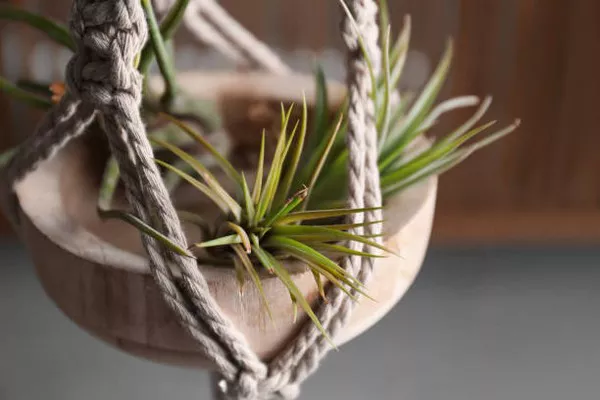Air plants, scientifically known as Tillandsia, are marvels of nature that captivate enthusiasts with their unique ability to thrive without soil. These intriguing plants belong to the Bromeliaceae family and encompass over 600 species, each exhibiting various adaptations to survive in diverse environments, from tropical rainforests to arid deserts. Despite their delicate appearance, air plants boast remarkable resilience, relying on a combination of specialized anatomical features, efficient water management strategies, and adaptive behaviors to flourish in the wild and as popular ornamental additions to indoor spaces.
Adaptations for Aerial Living
Air plants have evolved a plethora of adaptations that enable them to thrive in their aerial habitat. One of the most striking features of these plants is their ability to absorb water and nutrients through specialized trichomes—tiny scales or hairs covering their leaves. These trichomes are highly efficient in capturing moisture from the air, allowing air plants to extract water even in environments with minimal rainfall or humidity.
Furthermore, air plants possess unique anatomical structures that facilitate gas exchange. Unlike terrestrial plants with extensive root systems, air plants rely primarily on their leaves for respiration. Their leaves are often thin and flexible, maximizing surface area for the exchange of gases such as oxygen and carbon dioxide with the surrounding atmosphere.
Water Management Strategies
In their native habitats, air plants face unpredictable fluctuations in water availability, necessitating effective water management strategies to survive prolonged periods of drought. One such strategy is crassulacean acid metabolism (CAM), a physiological adaptation observed in many succulent and xerophytic plants, including certain species of Tillandsia.
CAM photosynthesis allows air plants to minimize water loss by opening their stomata at night, when temperatures are cooler and atmospheric moisture levels are higher. During this nocturnal phase, air plants absorb carbon dioxide and fix it into organic acids, which are stored in specialized cells within their tissues. Throughout the day, when stomata remain closed to reduce water loss, air plants utilize these stored acids to perform photosynthesis, thereby conserving water without sacrificing their metabolic activities.
Additionally, some air plant species exhibit a phenomenon known as “pupping,” where they produce offsets or new plantlets from the base of the mother plant. This reproductive strategy not only allows for the propagation of the species but also serves as a survival mechanism during periods of environmental stress. By producing offspring that can quickly establish themselves in nearby crevices or branches, air plants increase their chances of survival and genetic diversity within their populations.
Adaptive Behaviors
Beyond their physiological adaptations, air plants exhibit various adaptive behaviors that contribute to their survival in diverse environments. One such behavior is their ability to adjust their morphology in response to environmental cues. For instance, air plants may alter the orientation of their leaves or the density of their trichomes in accordance with changes in light intensity, temperature, or moisture levels.
Furthermore, air plants are adept at colonizing a wide range of substrates, including tree branches, rocks, and even telephone wires. This opportunistic behavior allows them to exploit new habitats and escape competition from other plant species. Additionally, their epiphytic lifestyle provides numerous advantages, such as increased access to sunlight and enhanced airflow, which further contribute to their overall health and vitality.
Cultural Significance and Horticultural Appeal
In addition to their ecological significance, air plants hold cultural and horticultural value, captivating people worldwide with their ethereal beauty and minimal maintenance requirements. From intricate terrarium arrangements to minimalist displays suspended in midair, air plants have become popular choices for interior decoration, adding a touch of greenery to homes, offices, and public spaces.
Furthermore, air plants have garnered attention from botanical enthusiasts and collectors who appreciate their diverse forms, vibrant colors, and intriguing growth habits. With proper care, including adequate light, air circulation, and occasional misting or soaking, air plants can thrive indoors, serving as living artworks that spark joy and fascination.
Challenges and Conservation Efforts
Despite their adaptability and widespread popularity, air plants face numerous threats in their native habitats, including habitat destruction, illegal collection, and climate change-induced alterations to precipitation patterns and temperature regimes. These challenges underscore the importance of conservation efforts aimed at preserving both wild populations and genetic diversity within cultivated collections.
Various organizations and initiatives are working to protect air plants and their ecosystems through habitat restoration, education and outreach, and sustainable harvesting practices. Furthermore, botanical gardens and arboreta play a crucial role in ex-situ conservation efforts, maintaining living collections of rare and endangered species for research, education, and future reintroduction into the wild.
Conclusion
Air plants exemplify the ingenuity of nature, showcasing a myriad of adaptations and behaviors that enable them to thrive in diverse and often challenging environments. From their specialized anatomical features to their efficient water management strategies and adaptive behaviors, air plants continue to captivate enthusiasts with their resilience and beauty.
As stewards of the natural world, it is incumbent upon us to appreciate and conserve these remarkable plants, ensuring that future generations have the opportunity to marvel at their splendor and learn from their extraordinary adaptations. By supporting conservation efforts and cultivating a deeper understanding of air plants and their ecological significance, we can contribute to the preservation of biodiversity and the continued wonder of our natural world.


